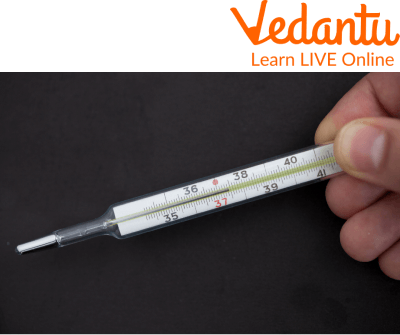




Overview of Mercury
Mercury is a chemical element which has an atomic number of 80. It is the only metal that is liquid at standard conditions. This liquid has a density close to that of water and a density greater than most other metals. It behaves similarly to a metal, but it reacts with water solution as if it were acid. At room temperature mercury has the highest thermal conductivity of any elemental solid, over four times the thermal conductivity of copper and nine times that of silver or gold.
In this article, we will study about the mercury and uses of mercury in the glass thermometers in detail.
What is Mercury?
Mercury is a shiny liquid that is colourless as well as transparent. As one may observe when a clean glass thermometer filled with mercury is held so that sunlight shines through, mercury has an inner glow. Mercury's liquid form has no memory of its previous shape, so it tends to flow when put in a container. This means that mercury is unshaped by dropping into a container, so it cannot be easily measured using what are called refractometers, but can be determined by dividing the volume at standard temperature and pressure by the density. The measurement used is known as a specific gravity. Now, let’s learn more about this important element.
Uses of Mercury in Everyday life

Use of Mercury to Test Diseases
Mercury is known for many uses, including:
As a chemical element and in the production of mercury-based products, such as thermometers
For its use in electroplating and silvering (see tinning)
As a fungicide or disinfectant
A contact lens disinfectant or preservative
As a pressurant or desiccant and as a dental amalgam alloy
In electrical contacts and switches which require high temperature operation with low corrosion
In India, it is used in the production of mercury lamps, and also used in military equipment.
As an additive to preservatives in concrete and plaster
As an ingredient to rubber compounds, detergents, dyes, adhesives, insulation compounds, paints
In photography, to make the image on film sensitive to light
Your ears can be used as an example to explain this phenomenon because they contain liquid mercury. When it is cold, the liquid inside your ears contracts, causing your ear canals to narrow.
Why is Mercury Used in Thermometer?
The thermometer is an instrument used to measure the temperature of objects. It indicates the temperature in degrees Celsius and has a glass tube filled with water or alcohol through which heat from objects is transferred to the liquid. The term for the instrument itself stems from the Greek word thermē meaning heat. Thermometers are one of those inventions that you don't really think about too often, but when you do, it's pretty disturbing.

Mercury Thermometer
Thermometers use mercury under pressure to measure the temperature of things—or in this case, the air around us. Yeah, something as important as how hot or cold we are involves dipping a needle into something toxic and using it to judge what is going on with our bodies!
Mercury's liquid property allows thermometers to work because they can expand or shrink depending on temperature. That gives them a range of 0 to 100 degrees Celsius. And the fact that mercury is poisonous allows doctors and scientists to more easily figure out if a person is sick. In this way, mercury plays an important role in our daily lives in ways we don't even realise. So next time you're taking your temperature, remember that mercury is the reason it's possible for you to know how hot or cold you are!
What is Mercury Thermometer?
A mercury thermometer is a thermometer that uses mercury to determine the temperature. It's filled with liquid mercury and an upward-pointing quill inside a glass tube. The density of the liquid metal causes it to collect at the tube's higher end when the mercury column in the tube is inverted.
The quill, thin and hollow, has its upper end in contact with air, so it’s buoyant and will rise or fall due to thermal expansion, which causes changes in volume of metal at either end. Dividing the volume of the quill by any glass tube's volume leads to an accurate estimation of temperature. The mercury level is adjusted (that is, raised or lowered) to make tall columns in glass tubes, which are about measurement distances apart. The level must also be calibrated with a liquid such as alcohol, air or water that is known to be of a known density at a known temperature.
Uses of Mercury in Glass Thermometer

Mercury in Glass Thermometer
The uses of mercury in glass thermometer include:
A glass thermometer is a type of thermometer that uses a column of liquid and mercury to show changing temperature.
Mercury thermometers are the oldest kind, dating back to the 1500s, and have been used for medical purposes since 1857.
It is a liquid in the tube that carries heat from one place to another.
Summary
In this article, we learned that mercury in a glass thermometer is there to provide an accurate measurement of the temperature. The mercury in a glass thermometer provides an accurate measurement of the temperature by expanding and contracting with temperature changes. We also learned that it is important for this liquid metal to surround the bulbous end where the temperature is measured because it can move much more easily than any other metal. This allows for quick response time between reading and changing, which is essential when taking medical or industrial measurements. We hope you enjoyed reading this article, in case of any other doubts, feel free to ask in the comments.
FAQs on Uses of Mercury in Thermometers
1. Why is mercury the preferred liquid for use in most traditional thermometers?
Mercury is ideal for thermometers due to several key properties. It has a uniform rate of thermal expansion, meaning it expands and contracts consistently with temperature changes, ensuring accurate readings. Additionally, mercury:
- Is opaque and silvery-white, making it easy to see inside the narrow glass tube.
- Does not stick to the glass, which prevents inaccurate measurements.
- Has a very high boiling point (356.7°C) and a low freezing point (-38.83°C), allowing it to measure a wide range of temperatures.
- Remains in a liquid state across a broad temperature spectrum.
2. What is a mercury-in-glass thermometer and what are its main applications?
A mercury-in-glass thermometer is a measuring device consisting of a glass bulb attached to a sealed, narrow-bore capillary tube. The bulb and a portion of the tube are filled with mercury. As the temperature changes, the mercury expands or contracts, causing its level in the capillary tube to rise or fall against a calibrated scale. Its primary applications include use in scientific laboratories, meteorological stations, and historically, in clinical thermometers for measuring body temperature.
3. How does a laboratory mercury thermometer differ from a clinical one?
The main difference lies in their design and purpose. A clinical thermometer is designed only to measure human body temperature and has a small range (e.g., 35°C to 42°C). It also contains a constriction or 'kink' that prevents the mercury from falling back immediately, allowing time to take a reading. A laboratory thermometer, on the other hand, measures a much wider temperature range (e.g., -10°C to 110°C) and does not have a kink, as it is meant to show the current temperature of a substance in real-time.
4. If mercury is so useful, why are mercury thermometers now considered dangerous?
Mercury is a highly toxic heavy metal. The primary danger arises when a thermometer breaks, releasing mercury vapour which can be inhaled, and liquid mercury which can contaminate surfaces and the environment. Long-term exposure or ingestion can cause severe damage to the nervous system, kidneys, and liver. Due to these health risks, many countries and health organisations have banned or phased out the use of mercury thermometers in favour of safer alternatives like digital or alcohol-based thermometers.
5. How does the principle of thermal expansion make a mercury thermometer work?
A mercury thermometer works on the principle that matter expands when heated. When the thermometer's bulb comes into contact with a hot object, it absorbs thermal energy. This energy causes the mercury inside to expand in volume. Because the mercury is enclosed within a very narrow capillary tube, even a slight increase in its total volume forces the liquid to rise significantly up the tube. The height to which it rises corresponds to a specific temperature marked on the calibrated scale next to the tube.
6. What are the common alternatives to mercury thermometers?
The most common alternatives to mercury thermometers are:
- Digital Thermometers: These use electronic sensors (thermistors) to measure temperature and display the reading on a digital screen. They are considered much safer, faster, and easier to read.
- Alcohol Thermometers: These use dyed alcohol (usually ethanol) instead of mercury. They are less toxic but have a lower boiling point, making them unsuitable for measuring very high temperatures. They are often used in general household and laboratory settings for non-critical measurements.
7. What are the correct precautions to take when reading a mercury thermometer in a lab?
For an accurate reading, it is important to follow the correct procedure. The thermometer should be held vertically, not tilted. Your eye must be positioned level with the top of the mercury column to avoid parallax error, which is an apparent shift in the reading when viewed from an angle. The bulb of the thermometer should be fully surrounded by the substance being measured and should not touch the bottom or sides of the container.









